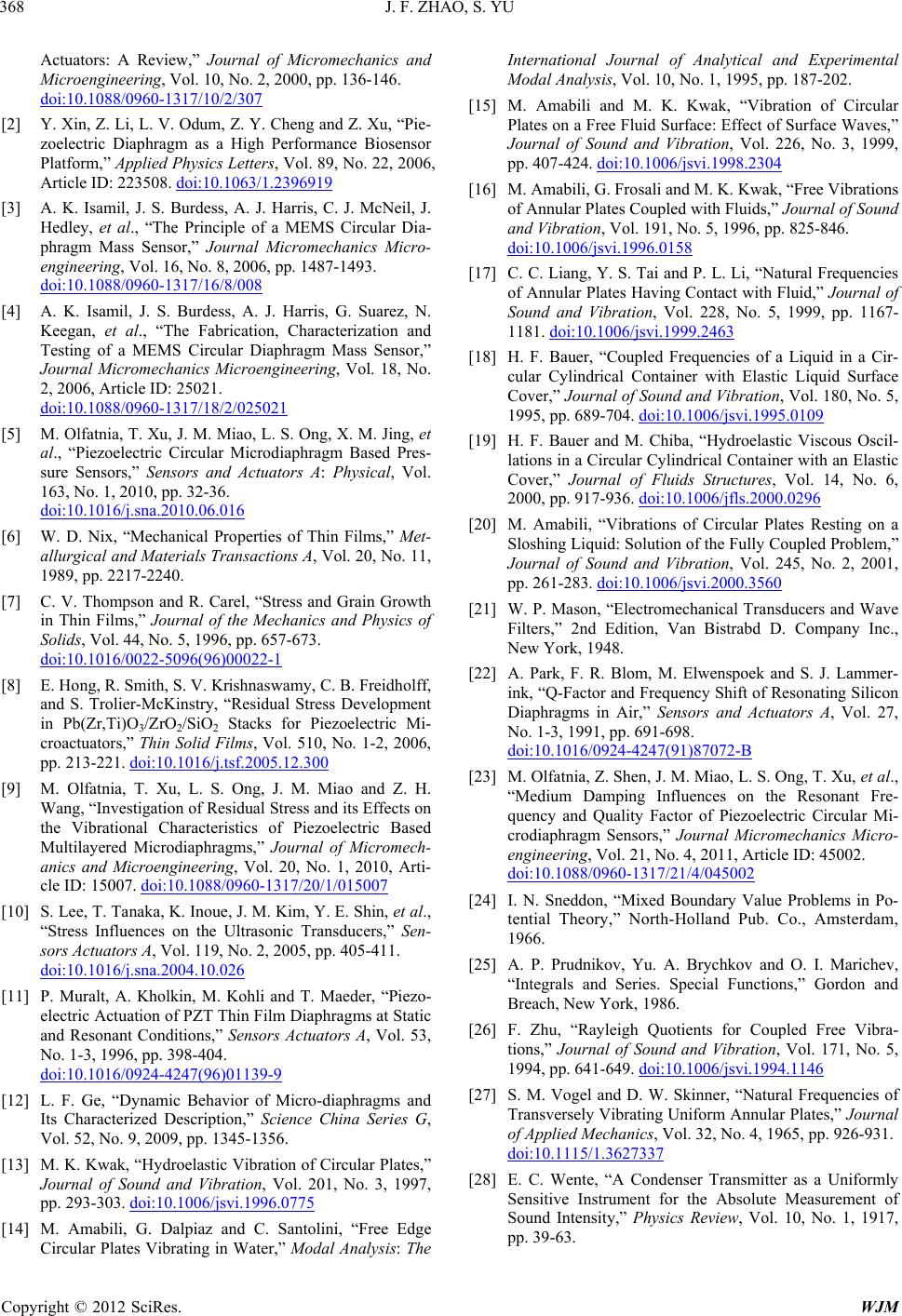
J. F. ZHAO, S. YU
Copyright © 2012 SciRes. WJM
368
Actuators: A Review,” Journal of Micromechanics and
Microengineering, Vol. 10, No. 2, 2000, pp. 136-146.
doi:10.1088/0960-1317/10/2/307
[2] Y. Xin, Z. Li, L. V. Odum, Z. Y. Cheng and Z. Xu, “Pie-
zoelectric Diaphragm as a High Performance Biosensor
Platform,” Applied Physics Letters, Vol. 89, No. 22, 2006,
Article ID: 223508. doi:10.1063/1.2396919
[3] A. K. Isamil, J. S. Burdess, A. J. Harris, C. J. McNeil, J.
Hedley, et al., “The Principle of a MEMS Circular Dia-
phragm Mass Sensor,” Journal Micromechanics Micro-
engineering, Vol. 16, No. 8, 2006, pp. 1487-1493.
doi:10.1088/0960-1317/16/8/008
[4] A. K. Isamil, J. S. Burdess, A. J. Harris, G. Suarez, N.
Keegan, et al., “The Fabrication, Characterization and
Testing of a MEMS Circular Diaphragm Mass Sensor,”
Journal Micromechanics Microengineering, Vol. 18, No.
2, 2006, Article ID: 25021.
doi:10.1088/0960-1317/18/2/025021
[5] M. Olfatnia, T. Xu, J. M. Miao, L. S. Ong, X. M. Jing, et
al., “Piezoelectric Circular Microdiaphragm Based Pres-
sure Sensors,” Sensors and Actuators A: Physical, Vol.
163, No. 1, 2010, pp. 32-36.
doi:10.1016/j.sna.2010.06.016
[6] W. D. Nix, “Mechanical Properties of Thin Films,” Met-
allurgical and Materials Transactions A, Vol. 20, No. 11,
1989, pp. 2217-2240.
[7] C. V. Thompson and R. Carel, “Stress and Grain Growth
in Thin Films,” Journal of the Mechanics and Physics of
Solids, Vol. 44, No. 5, 1996, pp. 657-673.
doi:10.1016/0022-5096(96)00022-1
[8] E. Hong, R. Smith, S. V. Krishnaswamy, C. B. Freidholff,
and S. Trolier-McKinstry, “Residual Stress Development
in Pb(Zr,Ti)O3/ZrO2/SiO2 Stacks for Piezoelectric Mi-
croactuators,” Thin Solid Films, Vol. 510, No. 1-2, 2006,
pp. 213-221. doi:10.1016/j.tsf.2005.12.300
[9] M. Olfatnia, T. Xu, L. S. Ong, J. M. Miao and Z. H.
Wang, “Investigation of Residual Stress and its Effects on
the Vibrational Characteristics of Piezoelectric Based
Multilayered Microdiaphragms,” Journal of Micromech-
anics and Microengineering, Vol. 20, No. 1, 2010, Arti-
cle ID: 15007. doi:10.1088/0960-1317/20/1/015007
[10] S. Lee, T. Tanaka, K. Inoue, J. M. Kim, Y. E. Shin, et al.,
“Stress Influences on the Ultrasonic Transducers,” Sen-
sors Actuators A, Vol. 119, No. 2, 2005, pp. 405-411.
doi:10.1016/j.sna.2004.10.026
[11] P. Muralt, A. Kholkin, M. Kohli and T. Maeder, “Piezo-
electric Actuation of PZT Thin Film Diaphragms at Static
and Resonant Conditions,” Sensors Actuators A, Vol. 53,
No. 1-3, 1996, pp. 398-404.
doi:10.1016/0924-4247(96)01139-9
[12] L. F. Ge, “Dynamic Behavior of Micro-diaphragms and
Its Characterized Description,” Science China Series G,
Vol. 52, No. 9, 2009, pp. 1345-1356.
[13] M. K. Kwak, “Hydroelastic Vibration of Circular Plates,”
Journal of Sound and Vibration, Vol. 201, No. 3, 1997,
pp. 293-303. doi:10.1006/jsvi.1996.0775
[14] M. Amabili, G. Dalpiaz and C. Santolini, “Free Edge
Circular Plates Vibrating in Water,” Modal Analysis: The
International Journal of Analytical and Experimental
Modal Analysis, Vol. 10, No. 1, 1995, pp. 187-202.
[15] M. Amabili and M. K. Kwak, “Vibration of Circular
Plates on a Free Fluid Surface: Effect of Surface Waves,”
Journal of Sound and Vibration, Vol. 226, No. 3, 1999,
pp. 407-424. doi:10.1006/jsvi.1998.2304
[16] M. Amabili, G. Frosali and M. K. Kwak, “Free Vibrations
of Annular Plates Coupled with Fluids,” Journal of Sound
and Vibration, Vol. 191, No. 5, 1996, pp. 825-846.
doi:10.1006/jsvi.1996.0158
[17] C. C. Liang, Y. S. Tai and P. L. Li, “Natural Frequencies
of Annular Plates Having Contact with Fluid,” Journal of
Sound and Vibration, Vol. 228, No. 5, 1999, pp. 1167-
1181. doi:10.1006/jsvi.1999.2463
[18] H. F. Bauer, “Coupled Frequencies of a Liquid in a Cir-
cular Cylindrical Container with Elastic Liquid Surface
Cover,” Journal of Sound and Vibration, Vol. 180, No. 5,
1995, pp. 689-704. doi:10.1006/jsvi.1995.0109
[19] H. F. Bauer and M. Chiba, “Hydroelastic Viscous Oscil-
lations in a Circular Cylindrical Container with an Elastic
Cover,” Journal of Fluids Structures, Vol. 14, No. 6,
2000, pp. 917-936. doi:10.1006/jfls.2000.0296
[20] M. Amabili, “Vibrations of Circular Plates Resting on a
Sloshing Liquid: Solution of the Fully Coupled Problem,”
Journal of Sound and Vibration, Vol. 245, No. 2, 2001,
pp. 261-283. doi:10.1006/jsvi.2000.3560
[21] W. P. Mason, “Electromechanical Transducers and Wave
Filters,” 2nd Edition, Van Bistrabd D. Company Inc.,
New York, 1948.
[22] A. Park, F. R. Blom, M. Elwenspoek and S. J. Lammer-
ink, “Q-Factor and Frequency Shift of Resonating Silicon
Diaphragms in Air,” Sensors and Actuators A, Vol. 27,
No. 1-3, 1991, pp. 691-698.
doi:10.1016/0924-4247(91)87072-B
[23] M. Olfatnia, Z. Shen, J. M. Miao, L. S. Ong, T. Xu, et al.,
“Medium Damping Influences on the Resonant Fre-
quency and Quality Factor of Piezoelectric Circular Mi-
crodiaphragm Sensors,” Journal Micromechanics Micro-
engineering, Vol. 21, No. 4, 2011, Article ID: 45002.
doi:10.1088/0960-1317/21/4/045002
[24] I. N. Sneddon, “Mixed Boundary Value Problems in Po-
tential Theory,” North-Holland Pub. Co., Amsterdam,
1966.
[25] A. P. Prudnikov, Yu. A. Brychkov and O. I. Marichev,
“Integrals and Series. Special Functions,” Gordon and
Breach, New York, 1986.
[26] F. Zhu, “Rayleigh Quotients for Coupled Free Vibra-
tions,” Journal of Sound and Vibration, Vol. 171, No. 5,
1994, pp. 641-649. doi:10.1006/jsvi.1994.1146
[27] S. M. Vogel and D. W. Skinner, “Natural Frequencies of
Transversely Vibrating Uniform Annular Plates,” Journal
of Applied Mechanics, Vol. 32, No. 4, 1965, pp. 926-931.
doi:10.1115/1.3627337
[28] E. C. Wente, “A Condenser Transmitter as a Uniformly
Sensitive Instrument for the Absolute Measurement of
Sound Intensity,” Physics Review, Vol. 10, No. 1, 1917,
pp. 39-63.